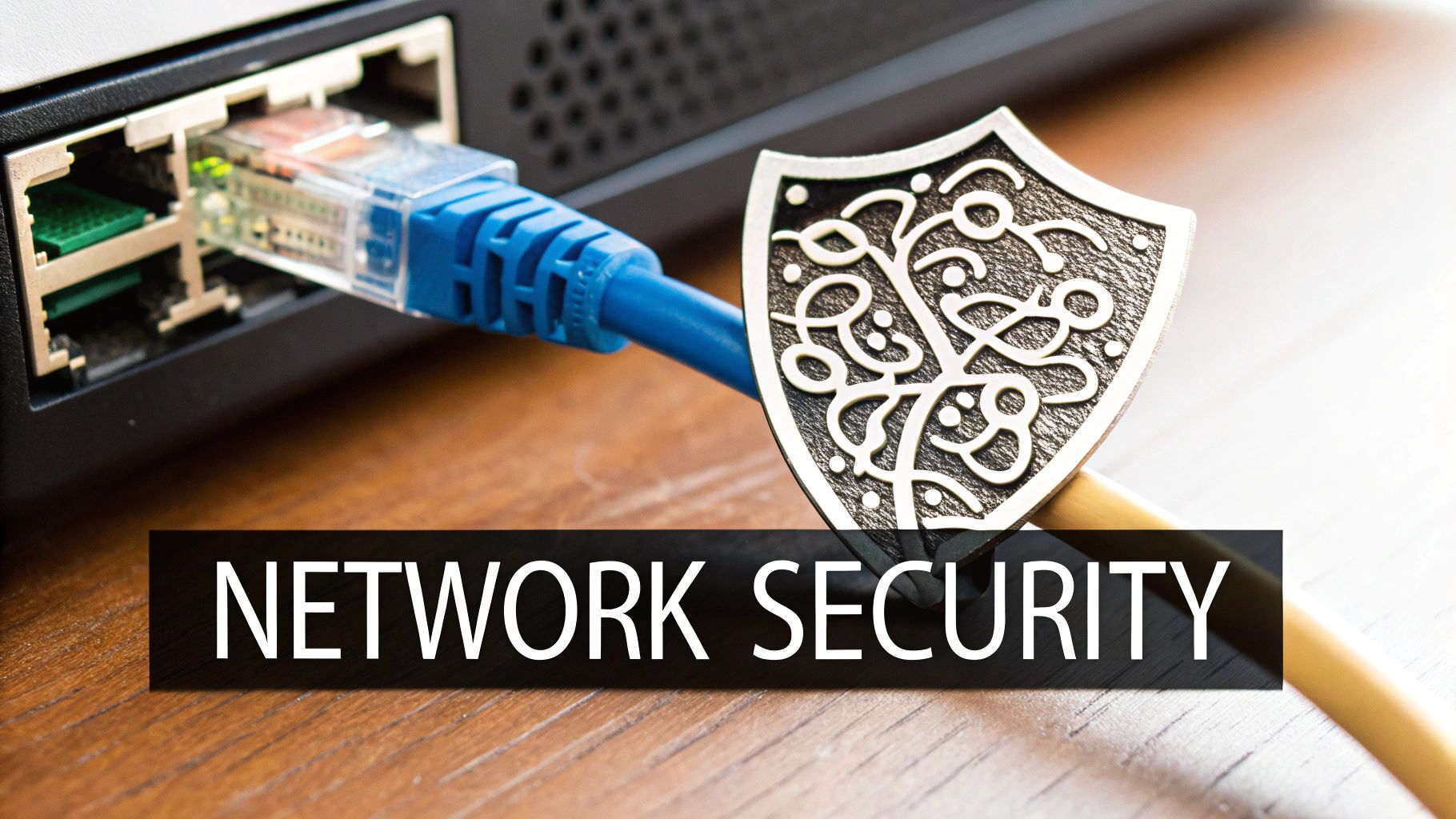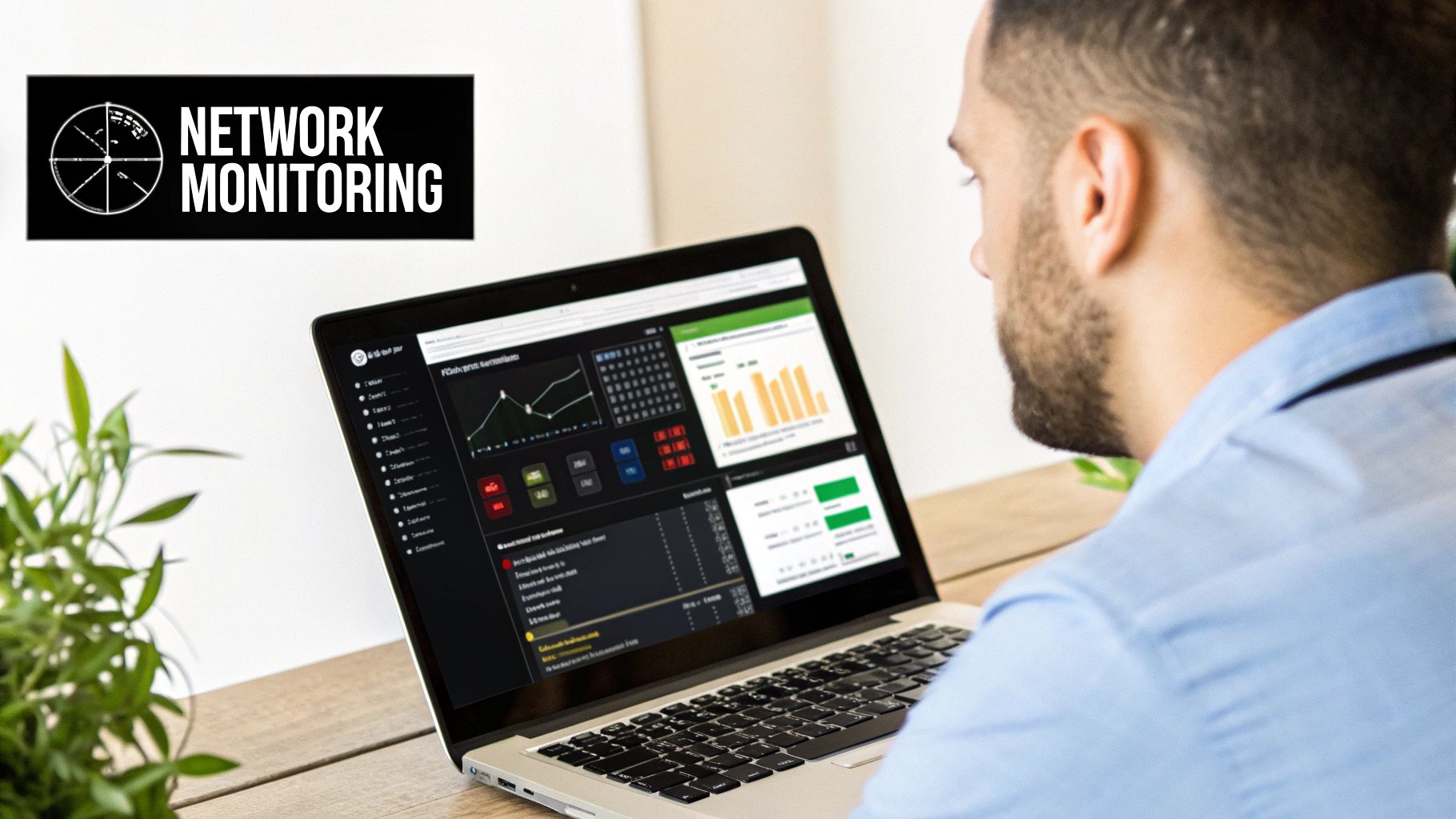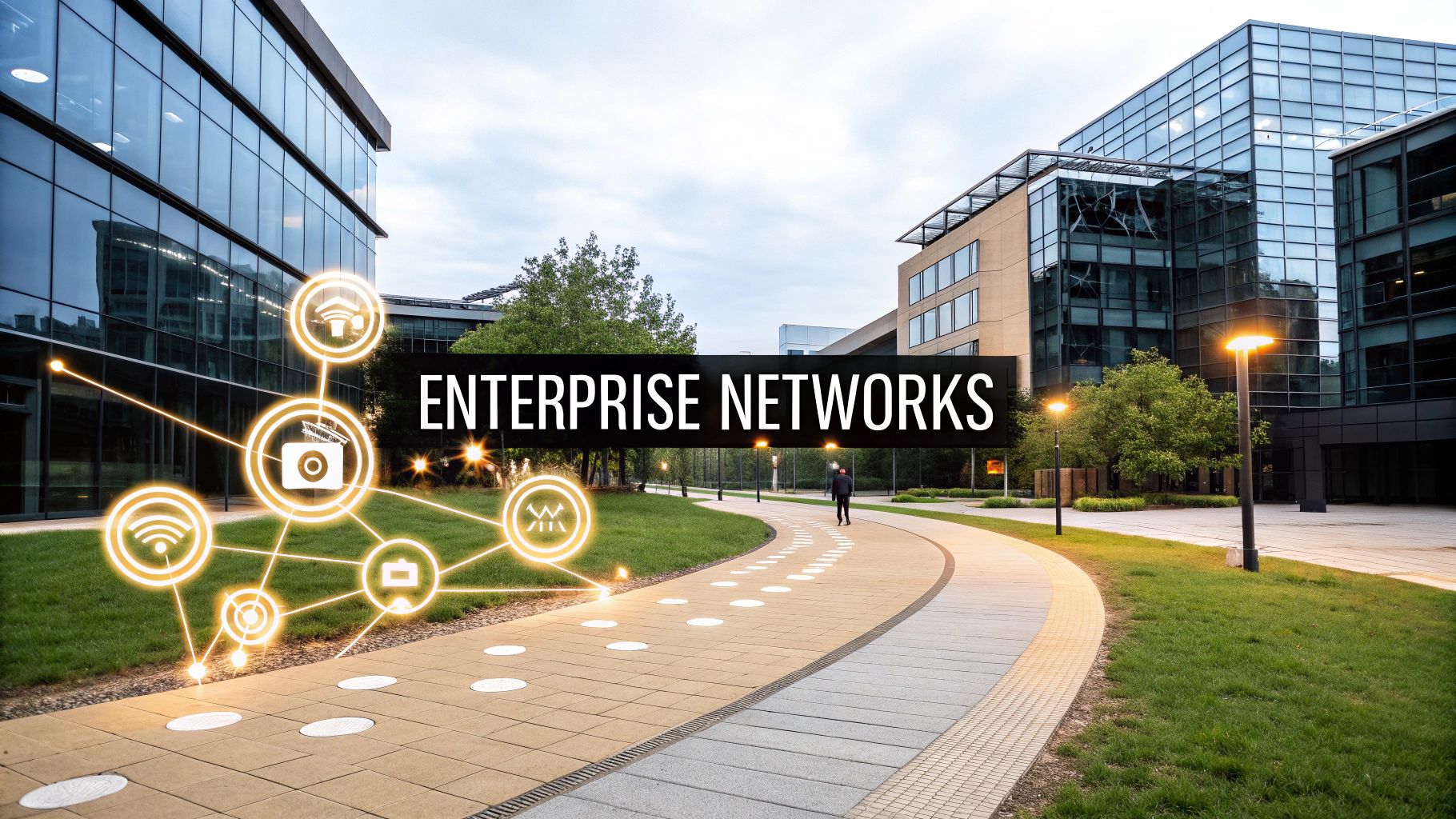At its heart, an enterprise network solution is the complete ecosystem of hardware, software, and services that acts as the digital backbone for a large organization. Think of it as the central nervous system, connecting all your users, devices, and critical applications across every location, powering everything from day-to-day tasks to long-term growth initiatives.
The Digital Foundation of Modern Business
Let’s use an analogy. Picture your business as a bustling city. The roads, the power grid, and the communication lines that keep everything moving are your enterprise network. Just as a city needs a solid infrastructure to handle commerce and daily life, a modern business absolutely requires a powerful network to manage the constant flow of critical data. This digital foundation is what enables every single part of your operation to function.
Without it, your most important business tools—cloud apps, communication platforms, data analytics—would simply grind to a halt. It’s the invisible engine ensuring your point-of-sale systems process transactions smoothly, your remote teams collaborate without a hitch, and your operational data gets to decision-makers in real time.
More Than Just an IT Expense
One of the biggest mistakes a business can make is viewing its enterprise network solutions as just another line item on an expense report. A well-designed network isn’t just a cost center; it’s a strategic asset that directly fuels productivity, resilience, and growth. It’s less about preventing downtime and more about creating a real competitive edge.
This mindset shift is clearly reflected in the market. The global enterprise networking market was valued at around $79.64 billion and is expected to jump to $87.1 billion the following year. That’s a serious level of investment from businesses that understand its importance. You can dig into more of these market trends over at The Business Research Company.
A modern enterprise network is the central nervous system of a company. It carries the signals—the data—that allow every other part of the organization to function, respond, and adapt.
Core Functions and Business Impact
At a fundamental level, an enterprise network has to perform several key functions to deliver real business value. These go way beyond just providing basic internet access and are essential for any large-scale operation. These systems are complex, and it’s worth understanding all the moving parts, including what cloud networking entails.
Here’s a look at the core functions and how they impact the business.
Core Functions of Enterprise Network Solutions
| Function | Business Impact |
|---|---|
| Connectivity | Ensures everyone—from HQ to remote staff—has fast, reliable access to the tools and data they need to do their jobs effectively. |
| Security | Protects sensitive company and customer data from cyber threats with tools like firewalls, preventing costly breaches and preserving trust. |
| Scalability | Allows the network to grow alongside the business, easily adding new users, devices, or locations without needing a complete and costly overhaul. |
These three pillars—connectivity, security, and scalability—are the absolute bedrock of a high-performing enterprise network. Getting them right is non-negotiable for any organization looking to compete and grow.
What Makes a Modern Enterprise Network Tick?
To really understand what an enterprise network solution does, you have to pop the hood and see how it all works. A modern network isn’t just a jumble of wires and boxes; it’s a precisely engineered system of powerful hardware and smart software, all working in concert. Think of it as the central nervous system for your entire business operation.
The most tangible parts are, of course, the hardware. These are the physical devices that move, manage, and protect the flow of data across your organization. Each piece has a specific, crucial job to do to keep everything online and running without a hitch.
The Key Hardware Players
This foundational hardware creates the physical superhighways for your data. You can think of these components as the specialized crew on a digital assembly line, each with a distinct role.
- Switches: These are the local traffic cops for your internal network. They create the networks inside your buildings, intelligently sending data packets only to the specific devices that requested them. This is how all the computers, printers, and phones in a single office can talk to each other efficiently.
- Routers: If switches manage local traffic, routers are the long-haul navigators connecting different networks. They find the best possible path for data to travel from your main office to a remote employee’s house, a branch location, or a cloud server, ensuring information gets where it needs to go, no matter the distance.
- Firewalls: Think of a firewall as your network’s hyper-vigilant security guard. It stands at the very edge of your network, meticulously inspecting every piece of data coming in or going out. Its job is to block malicious threats and enforce your security policies, protecting your sensitive company data from anyone who shouldn’t see it.
- Wireless Access Points (WAPs): These are the unsung heroes of modern mobility. WAPs are what provide the Wi-Fi that everyone relies on, allowing laptops, smartphones, and IoT devices to connect to the network without being physically plugged in. They’re essential for creating a truly flexible work environment.
This image shows how all these components come together in a typical server room to form a scalable and powerful infrastructure.

As you can see, a well-designed network isn’t just a random collection of hardware. It’s a cohesive system built from the ground up to support growth and collaboration.
The Brains of the Operation: Intelligent Software
Hardware provides the muscle, but software provides the intelligence. This is where modern enterprise networks have truly evolved, using sophisticated software to automate, optimize, and secure the system in ways hardware alone never could.
Software-defined technologies add a layer of intelligence that makes the entire system more flexible, automated, and responsive to ever-changing business demands.
This shift is largely driven by technologies like Software-Defined Networking (SDN) and SD-WAN. What they do is brilliant in its simplicity: they separate the network’s control panel from the physical hardware. This allows administrators to manage the entire network—across multiple locations—from a single, centralized dashboard.
The result is incredible agility. Imagine you have a critical all-hands video conference. With a few clicks, you can instantly prioritize that video traffic across the entire network to guarantee a smooth, buffer-free experience for everyone. For a deeper dive, check out our guide on how your organization can benefit from flexible networking solutions.
This software-centric approach is a major factor behind the massive growth in the enterprise network market. Valued at $68.94 billion, it’s projected to explode to nearly $115.87 billion by 2034, all because businesses need smarter, more adaptable networks to compete.
The Real-World Benefits of a Network Upgrade
Putting money into a modern enterprise network is about so much more than just getting faster download speeds. It’s about unlocking real, tangible advantages that ripple through your entire business, from the server room all the way up to the boardroom. Think of it as a direct investment in your core operations—security, productivity, and future growth—that delivers a clear and measurable return.
One of the most immediate gains is a massive leap forward in your security. Older networks often lean on a single, outdated firewall. That’s like posting a lone security guard to protect an entire city. Modern solutions, on the other hand, weave security into every layer of the network. This includes sophisticated AI-driven threat detection that actively hunts for and stops unusual activity before it can do any real damage.

Driving Productivity and Efficiency
Reliable, high-speed connectivity is the very pulse of a productive team. When your network is solid, your people have the tools to do their best work, whether they’re at the main office, a branch location, or working from home. A slow, spotty connection isn’t just an annoyance; it’s a direct drain on productivity and morale.
Take a hospitality group, for example. A robust network ensures their property management systems are always snappy, so front desk staff can check in guests without those frustrating delays. In a commercial building, teams can collaborate on huge files or jump on video calls without the lag that completely kills momentum. It all adds up to smoother operations and, ultimately, a better experience for your customers.
Unlocking Scalability and Strategic Focus
Your network should be an engine for growth, not a roadblock. Modern enterprise network solutions are built from the ground up to be scalable, meaning they can easily grow right alongside your organization. Adding a new building, bringing more IoT devices online, or onboarding an entire new team becomes a straightforward adjustment, not a massive, costly overhaul.
This flexibility is supercharged by centralized management tools. Instead of sending IT technicians out to physically configure devices at different sites, your team can manage the whole network from a single, intuitive dashboard. The impact of this automation is huge.
By simplifying routine management, centralized tools free up your valuable IT staff. They can shift their focus from tedious, time-consuming tasks to strategic initiatives that create new value and drive the business forward.
This shift turns your IT department into a genuine strategic partner, one that’s focused on innovation instead of just keeping the lights on. The benefits of this elevated focus are clear:
- Improved Employee Empowerment: With a dependable network, your staff can use modern tools without friction, boosting both job satisfaction and their output.
- Enhanced Security Confidence: Knowing your data is wrapped in multiple layers of intelligent security gives leadership and clients invaluable peace of mind.
- Effortless Business Growth: Your network can expand whenever you need it to, supporting new ventures and locations without forcing a complete do-over.
How AI Is Rewriting the Rules of Networking
Artificial intelligence isn’t just a buzzword anymore—it’s actively changing how enterprise networks function. It’s turning them from rigid, manually managed systems into smart, self-adjusting infrastructures that solve real business problems.
Think of an AI-powered network as a self-driving car. The car constantly processes data from its surroundings—road conditions, traffic, driver inputs—to make smart decisions on the fly. In the same way, an AI network analyzes a constant stream of information from every user, device, and application to manage data flow with a new level of intelligence.
Predictive Analytics and Proactive Management
One of the biggest game-changers AI brings to networking is the ability to see problems coming before they actually hit. Instead of scrambling to fix an outage after your business is already impacted, AI algorithms look for subtle patterns in network performance that signal trouble ahead.
For example, an AI might notice a single wireless access point in a busy common area of a senior living facility is showing a tiny bit more latency every afternoon. It can flag this as a potential hardware failure, giving your IT team a heads-up to swap it out during a quiet period. This simple, proactive fix prevents a full-blown outage that could knock out residents’ internet access or even critical safety devices.
By learning what “normal” looks like for your network, AI-powered systems can instantly spot any deviation. This moves you from a reactive, “break-fix” model to a much more effective proactive one.
Intelligent Traffic Optimization and Security
Today’s networks are a mixed bag of traffic, juggling everything from critical payment processing to employees streaming music. AI-driven enterprise network solutions can automatically sort and prioritize all this data, making sure the most important applications always have the bandwidth they need. This is a massive benefit for a hotel, for instance, where the point-of-sale and reservation systems absolutely must remain fast and reliable.
This smart automation is also a huge deal for cybersecurity, especially with so many people working remotely. The market growth reflects this demand; the Asia Pacific region alone accounted for $83.34 billion in a single year and is projected to reach $148.76 billion by 2034. You can see the complete data by reading the analysis of the expanding enterprise networking market on Precedence Research.
By catching strange behavior in real-time—like a user suddenly trying to access sensitive files from a new, unrecognized location—AI strengthens your security without needing a human to constantly watch over it. It effectively turns your network into a vigilant, self-defending platform.
Choosing the Right Enterprise Network Solution

Picking the right infrastructure for your business is a high-stakes decision that hits your bottom line directly. It’s about so much more than just buying tech; it’s about choosing a partner and a platform that can genuinely support your goals for years to come. This means you have to look far beyond the initial price tag to understand what you really need.
The first step? Get brutally honest about your current network’s weak spots. Are remote employees constantly griping about slow VPN connections? Does your Wi-Fi crumble under the pressure in high-traffic zones like a hotel lobby or a packed apartment complex clubhouse? Pinpointing these frustrations gives you a concrete list of problems that any new solution absolutely must solve.
From there, you can start mapping out your future needs. Don’t just plan for today. Think about where your business is headed in the next three to five years. That might mean supporting a growing number of remote or hybrid workers, adding more IoT devices like smart locks and thermostats, or even expanding to new properties.
Look Beyond the Initial Price Tag
One of the most common mistakes I see is businesses getting fixated on the upfront cost of hardware and installation. A much smarter way to look at it is through the lens of Total Cost of Ownership (TCO), which gives you a far more accurate picture of your long-term investment. TCO covers not just the initial purchase but all the ongoing operational costs, too.
The true cost of a network isn’t what you pay for the boxes. It’s the sum of initial setup, ongoing management, power consumption, potential downtime, and future upgrade expenses.
Think about it this way: a system with a lower sticker price that requires constant manual babysitting can be a real drain. The staff hours spent on maintenance can quickly wipe out any of those upfront savings. On the flip side, a solution with a higher initial cost but with powerful automation and simplified management can slash your operational expenses over time.
This is a big reason why many businesses are now exploring more flexible payment structures. For example, understanding how a Network as a Service (NaaS) model can make this more accessible and predictable is a great starting point.
Vet Your Vendor as a Long-Term Partner
When you choose an enterprise network solution, you aren’t just buying a product. You’re starting a long-term relationship with the vendor. The quality of that partnership is every bit as important as the technology itself. A great vendor becomes an extension of your own team, offering support and guidance when you need it most.
Before you sign on the dotted line, you need to do your homework. The table below outlines the key questions you should be asking to make sure you’re picking a true partner, not just a supplier.
Solution Selection Checklist
| Criteria | Key Questions to Consider |
|---|---|
| Vendor Partnership | Do they have a proven track record in your industry (hospitality, senior living, etc.)? Can you speak to their existing clients? |
| Scalability & Future-Proofing | Does the solution easily scale up or down? What is their technology roadmap for the next 3-5 years? |
| Security Approach | How do they handle threat detection and response? What security certifications do they hold? |
| Total Cost of Ownership (TCO) | What are the ongoing costs for licensing, maintenance, and support? Are there hidden fees? |
| Deployment & Management | How complex is the initial setup? Does the platform offer a single-pane-of-glass dashboard for easy management? |
| Customer Support | Is support available 24/7? Do they offer a dedicated account manager or a tiered support system? What are their guaranteed response times? |
By digging into these areas, you move beyond a simple feature comparison. You’re evaluating the vendor’s commitment to your success, ensuring you select a partner who will help your business grow and adapt for years to come.
Frequently Asked Questions About Enterprise Networks
Stepping into the world of enterprise networking can feel like learning a new language. As you start comparing different setups and strategies, questions about cost, security, and long-term value are bound to come up. Let’s clear the air and tackle some of the most common questions we hear from business leaders and IT managers.
Standard Business Network vs Enterprise Network
The biggest difference boils down to three key things: scale, complexity, and performance. A standard business network is great for a small office. It handles basic internet access and file sharing for a handful of people and devices. Think of it as a quiet neighborhood street.
An enterprise network, on the other hand, is the national highway system. It’s built from the ground up to connect hundreds or even thousands of users, run demanding cloud applications, and manage huge amounts of data across multiple locations. These networks are engineered with advanced security, high availability (meaning they have built-in redundancy to prevent outages), and centralized management to handle the intense demands of a large-scale operation.
How Enterprise Network Solutions Improve Security
Modern solutions don’t just put a lock on the front door; they build security into every layer of the network. This approach is often called “defense in depth.”
Enterprise-grade security isn’t a single wall; it’s a layered fortress. It’s about creating multiple checkpoints and intelligent surveillance systems that protect data from every possible angle.
This comprehensive strategy combines several powerful elements:
- Network Segmentation: This is the practice of walling off different parts of your network. For instance, your guest Wi-Fi is kept completely separate from your internal corporate network. That way, a security hiccup in one area can’t spread and compromise your entire system.
- Advanced Threat Detection: Many solutions now use AI to constantly watch network traffic. This allows them to spot and block suspicious activity in real-time, neutralizing threats before they can cause damage.
- Secure Access Controls: These rules ensure people and devices only get access to the specific files and applications they’re authorized to use. This is absolutely critical for safely managing a hybrid workforce and the growing number of IoT devices on your network.
By layering these protections, you create a far more resilient and secure environment for your company’s most important information. For a deeper dive, you can also explore our guide on how to enhance network hardware security.
Is SD-WAN a Replacement for My Current Network?
Not exactly. It’s better to think of SD-WAN (Software-Defined Wide Area Network) as a smart upgrade that works with the internet connections you already have. It acts as an intelligent control layer that manages your various connections—like MPLS, broadband, and 5G—to make them all work together more efficiently.
Think of it like this: SD-WAN adds a software “brain” on top of your physical internet lines. This brain intelligently steers your data traffic based on what’s most important, current network conditions, and your security rules. It might push a critical video conference over your most stable connection while sending a routine data backup over a standard broadband line. The result is better performance for your cloud apps, much simpler management for your branch offices, and often, significant cost savings.
How to Future-Proof a Network Investment
Future-proofing your network is all about choosing solutions built for change. It means prioritizing scalability, flexibility, and adaptability so your investment stays relevant for years, not just months.
First, look for solutions built on open standards instead of proprietary technology. This keeps you from being locked into one vendor, giving you much more freedom down the road. It’s also smart to prioritize software-defined technologies like SDN and SD-WAN. They let you adapt to new business needs through simple software updates rather than expensive and disruptive hardware overhauls.
Finally, make sure any solution you consider has a clear plan for integrating emerging tech like Wi-Fi 6E, 5G, and advanced AI. Choosing a vendor with a strong reputation for innovation means you’re getting a partner who will grow right alongside your business.
Ready to build a network that grows with you? Clouddle Inc provides managed technology solutions that combine cutting-edge security, networking, and Wi-Fi services with zero down payment options and 24/7 support. Discover how our Network-as-a-Service offering can optimize your operations and protect your assets by visiting https://www.clouddle.com.


